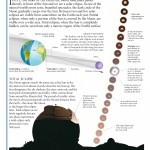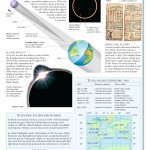In its 27 – day Orbit of the Earth, the Moon sometimes passes directly in front of the Sun and we see a solar eclipse. In one of the natural world’s most eerie, beautiful spectacles, the dark circle of the Moon gradually creeps over the Sun.
Between two and five solar eclipses are visible from somewhere on the Earth each year.
When the Moon is at its farthest from the Earth, it is not big enough in the sky to cover the Sun completely during an eclipse. Instead of a total eclipse, an annular eclipse occurs. When the Moon is exactly in front of the Sun, a bright ring of the Sun’s photosphere is still visible around the edge of the Moon.
Related posts:
When a Metorite collides with Earth it can form an impact crater – a bowl – shaped hollow in the Earth’s surface. Space rocks have produced in this way throughout Earth’s life, especially when the planet was young, about 4 billion years ago. Space rocks do not have to hit Earth to have a devastating effect. On june 30, 1908, there was an explosion 3.5 miles up in Earth’s atmosphere, above...
The “dark flow” of wayward galaxy clusters that appear to be pulled in one direction could give us our first hint of something beyond the cosmic horizon, which normally marks the limit of the observable universe.
The square of Pegasus is the key pattern to look for. Its four stars, although not particularly bright, are easy to find because there are few other stars around.
The Space Capsule has been developed for NASA to service the International space station; the reusable Dragon capsule is lofted into orbit by Spacex’s Falcon 9 rocket. While the first flights are to carry cargo only, the capsule was designed to be capable of carrying up to seven astronauts.
Atomic theory is a theory of the nature of matter, which states that matter is composed of discrete units called atoms, as opposed to the obsolete notion that matter could be divided into any arbitrarily small quantity. The Atoms are subdivided into Nucleus. The Nucleus is formed with thousands of Nucleons. The Nucleons are again subdivided into Quarks. No matter how these are discovered, these di...
The divine circle might be acknowledged to be interminable in sweep. This denotes any focus within it, incorporating that involved by the spectator, might be recognized the inside. It moreover indicates that everything parallel lines, be they millimeters separated or crosswise over the Earth's planetary group from one another, will appear to cross the circle at a lone indicate, comparable to the v...
Today man has started a striking and driven revamped space drive to prepare us to investigate revamped worlds, improve more creative mechanics, cultivate revamped commercial ventures, build our perceiving of the earth, unfold our presence in the earth's planetary group, and motivate the cutting edge of travellers.
A red monster is an iridescent monster star of level or halfway mass (harshly 0.5–10 sun oriented masses) in a late stage of stellar development. The external environment is swelled and tenuous, making the span monstrous and the surface temperature flat, an as yet undisclosed place from 5,000 K and easier. The manifestation of the red monster is from yellow orange to red, incorporating the unearth...
The planet Jupiter has 67 affirmed moons. This gives it the most substantial entourage of moons with "sensibly secure" circles of any planet in the Sun oriented System. The most monstrous of them, the four Galilean moons, were identified in 1610 by Galileo Galilei and were the first protests recognized to circle a figure that was not Earth or the Sun. From the close of the 19th century, handfu...
Saturn is the sixth planet from the Sun and the second vastest planet in the Earth's planetary group, following Jupiter. Named following the Roman god Saturn, its galactic image (♄) speaks for the god's sickle. Saturn is a gas goliath with a normal span something like nine times that of Earth.[12][13] While a single-eighth the middle thickness of Earth, with its more substantial volume Saturn ...
Uranus is the seventh planet from the Sun. It has the third-most vast planetary span and fourth-most impressive planetary mass in the Earth's planetary group. Uranus is comparative in arrangement to Neptune, and both are of offbeat substance structure than the more vast gas goliaths Jupiter and Saturn. Astrochemists in some cases place them in a marked classification called "ice goliaths". Ura...
NASA’s Constellation program comprises a set of launch boosters, space vehicles and support modules that together will place humans on the moon by 2020. Plans call for astronauts to stay on the lunar surface for periods ranging from four days to more than six months.
In 1659 Dutch astronomer Christian Huygens, using an early telescope, drew the first sketch of a surface feature on Mars, a dark patch know today as Syrtis Major. More than three centuries later the mars global Surveyor is charting the entire planet. Data beamed from the orbiting surveyor have rendered a detailed and true-color map of this seemingly most Earthlike of planets.
All of the stars in “The size of our world” and all the stars you can see in the sky are only in our own galaxy ! What lies beyond our galaxy? It is a great miracle to know about these facts. The Hubble space telescope kept its camera pointed there for over 4 months, taking in all the light it could. The area, about a tenth the size of the full moon, appeared to be complete blackness with no st...
The Lunar Module basically consists of many electronically connected parts that helps the Module complete. It mainly consists of the Docking Window, The Antenna to receive and send the signals, the Docking Lights, The Tracking Light, The Forward Hatch, The Mesa, The Ladder to get into the Module, the Egress Platform, The Rover, The Landing Probe, the Overhead Hatch, the Docking Target, the Eva...
Most astronomers believe that all the members of the solar system, from the giant Sun to the smallest asteroid, were born out of a vast, spinning cloud of gas and dust – the solar nebula. The process began 5 billion years ago with the formation of the Sun. The planets and other objects formed from unused material. When the solar system was nearly complete, 500 million years later, just 0....
The planets are very far away. A spacecraft traveling at 60 mph a typical speed of a car on a highway – would take about 60 years to reach Mars. Fortunately, rockets travel much faster than this. The Voyager spacecraft sped from the Earth at 32000 MPH. But even at this speed, travel to the planets takes a long time. The Future space colonies will have to be self – sufficient, growing t...
Spacetime is CONSTANT (always 100%). Both time and space are maileable – they can change within spacetime, but no matter how big or small one part is, THE TOTAL IS ALWAYS 100% - so TIME TRAVEL IS POSSIBLE, in fact, we’re ALL traveling through time right now !!!!!



 Upload your infographic here and contribute to our community.
Upload your infographic here and contribute to our community. 
Leave a Reply